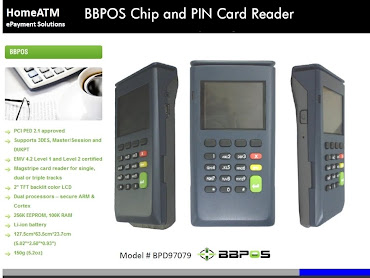There's a Perfect Storm Brewing and HomeATM is Perfectly Positioned...
Editor's Note: What a wonderfully pleasant surprise. Mainstream media is finally beginning to understand and write about the impact debit cards will have in shaping the purchasing habits of consumers in the foreseeable future.
Their next giant step would be to understand and write about the "Paradigm Shift" occurring within those very same consumers' preference to "shop online" versus "at retail stores" and then put the two together (click here to view this unbelieveable chart from eMarketer ) .
Only then would they possess the beginnings of a decent understanding of the future of the payments industry. They would still need to include other variables, such as convenience, security, angst from retailers against high interchange fees, the increase in fraud, decrease in consumer trust, etc. to be able predict with any accuracy at all, the future of online payments. But they'd have a good foundation with which to play.
Excuse the cliche' but it really doesn't take a rocket scientist to figure it out: Consider these current trends:
 Debit card use grows...
Debit card use grows...
credit card use decreases- Online shopping grows...
bricks and mortar shopping decreases. - Online Fraud grows...
consumer trust in security decreases - POS Tampering grows... consumer trust in public POS device decreases
- Retailers Angst Over Interchange grows, V/MC's Ability to Justify decreases
Now...Let's imagine for a moment that someone was to devise a way for "online shoppers "to use their "debit card" while "reducing fraud", and eliminating tampering...they just very well might be on the right track. Take into consideration all those retailers who are up in arms over the high cost of Interchange Fees and in addition to providing the aforementioned benefits here's another: By using this system, your Interchange Fees would be cut in half! The last piece of the puzzle has been placed. Like I said, Perfect Storm, Perfect Place. The eye of the tiger...
The Steady Ascent of the Debit Card - BusinessWeek
The Steady Ascent of the Debit Card
Debit cards may soon overtake credit cards, which is why banks are scrambling to boost their profitability
By Christopher Palmeri
For consumers reeling from a series of economic body blows, debit cards are increasingly becoming the plastic of choice. Some use the cards, which pull money directly from a bank or other account, as a budgeting tool to limit spending. Others are embracing them out of necessity as banks clamp down on credit.
All told, debit purchases are expected to climb 13% in 2008, to $1.2 trillion, according to The Nilson Report, an industry newsletter—compared with a 3% rise, to $1.9 trillion, for credit-card transactions. At Visa (V), the No. 1 card company, debit spending could surpass credit this year.
For the banks issuing the debit cards, the trend seems bittersweet. On the plus side, debit cards don't pose a threat to the banks' books like credit-card accounts; losses are mounting as borrowers fall behind on their payments. But the profits on debit cards aren't as plump since banks don't collect interest on them. Issuers largely make money from fees, which (on debit cards) pale next to those on credit cards. Retailers, for instance, three times the amount (they would pay for) on debit transactions.
The Next Frontier
Regulatory headwinds haven't deterred the banks from ramping up their debit-card businesses. Among the groups that offer the biggest potential for banks: people who earn more than $75,000 a year. According to MasterCard (MA), they're the least active debit users, usually turning instead to credit cards that offer frequent-flier miles and other rewards.
The aggressive push is paying off. These days, debit cards are as widespread as credit cards.
 "Debit is becoming the payment card of choice for the American public," says Red Gillen of consultancy Celent. At the upscale suburban Atlanta restaurant Aqua Blue, waitresses now bring diners a device that lets them swipe their debit card and enter their PIN to pay for meals.
"Debit is becoming the payment card of choice for the American public," says Red Gillen of consultancy Celent. At the upscale suburban Atlanta restaurant Aqua Blue, waitresses now bring diners a device that lets them swipe their debit card and enter their PIN to pay for meals. Editor's Note: That's "exactly" "my point"...of sale...it's what HomeATM does for the online shopper. We provide the device that allows online shoppers to swipe their debit (and/or credit) card and enter their PIN to "securely" pay for goods bought online" And in this "Perfect Storm" HomeATM is starting to see that they have been correct in their approach to bring secure "card present" and PIN based web transactions from ANY web device. The way we see it...
"if you can't bring the consumer to the point of sale device,
bring the point of sale device to the consumer"
What Makes the Card Present is the Ability to Present the Card
What Makes the Card Present is the Ability to Present the Card




 The Merchant Risk Council (MRC) is pleased to announce the Keynote and Closing speakers for MRC's 7th Annual e-Commerce Payments and Risk Conference at the Wynn Las Vegas Resort on March 10-12, 2009. Terry Jones, founder of Travelocity.com, has been chosen to deliver the opening keynote speech. Chris Hansen, Dateline NBC correspondent, will be delivering the conference's closing speech.
The Merchant Risk Council (MRC) is pleased to announce the Keynote and Closing speakers for MRC's 7th Annual e-Commerce Payments and Risk Conference at the Wynn Las Vegas Resort on March 10-12, 2009. Terry Jones, founder of Travelocity.com, has been chosen to deliver the opening keynote speech. Chris Hansen, Dateline NBC correspondent, will be delivering the conference's closing speech.











